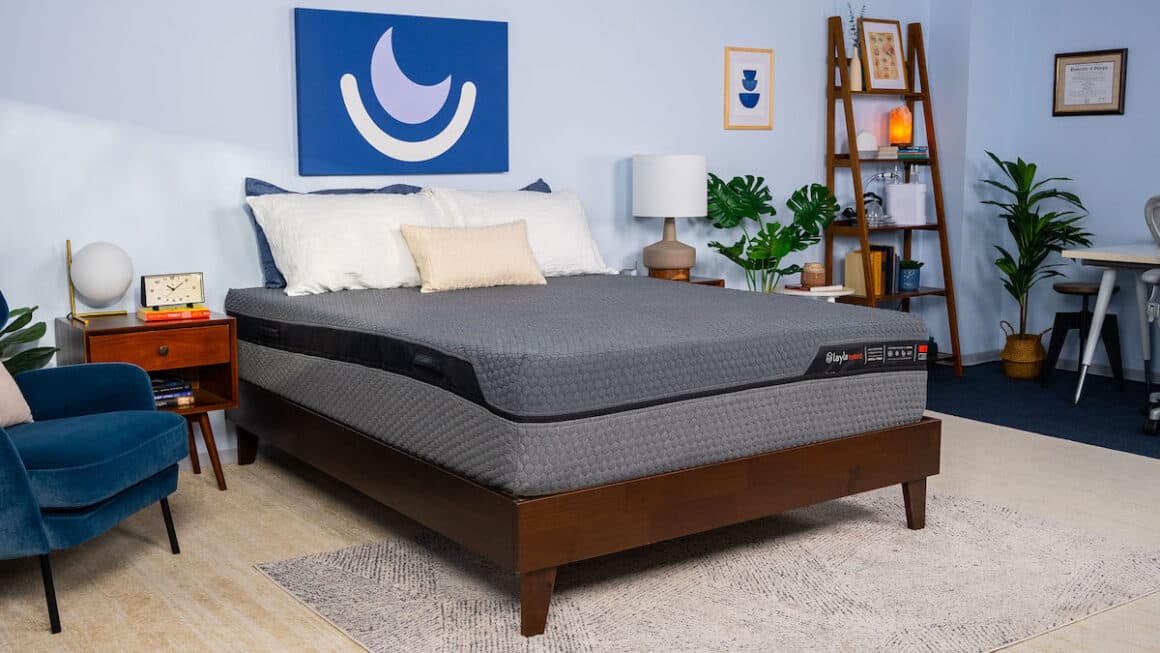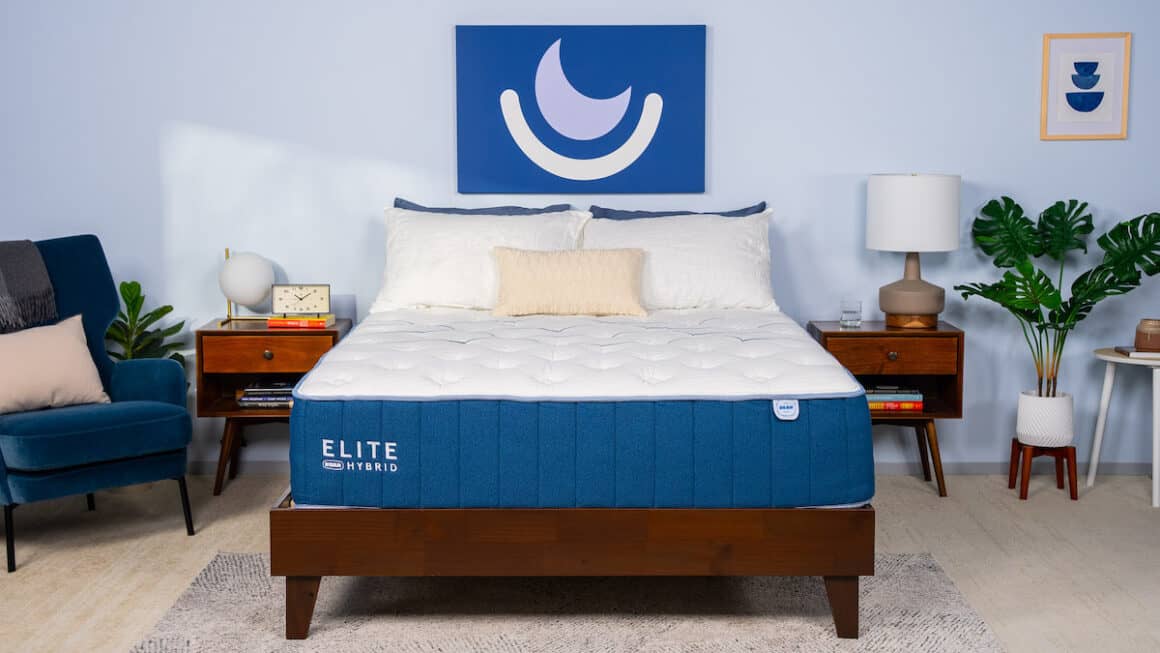On This Page
Best Mattress for Fibromyalgia
Our Top Picks
-
Best Overall
Helix Midnight Luxe -
Best Value
Layla Hybrid -
Most Comfortable
Nectar Premier -
Best Luxury
Saatva Latex Hybrid -
Best for Back Pain
Bear Elite Hybrid -
Best for Pressure Relief
Nolah Natural 11
Best Overall

The Midnight Luxe is one of Helix Sleep’s most popular mattresses, and it’s easy to see why — adaptive foam over robust coils creates an appealing balance of cushioning, support, bounce, and temperature control. People with fibromyalgia who primarily sleep on their side or back should receive the relief they need from this mattress.
Pros & Cons
Pros
- Cushy foam layers contour evenly and soothe sore spots
- Reinforced perimeter coils protect the edges from excessive sinkage
- Two cooling cover options
Cons
- Back and stomach sleepers over 230 pounds may not receive enough support
- Initial off-gassing odor is fairly strong
Ratings
Our Take
Best Value

The flippable Layla Hybrid’s versatile design makes the mattress a great choice for anyone with fibromyalgia-related pain, whether they prefer a plush or firm surface. Memory foam comfort layers deliver deep, even cushioning for sore spots while the robust pocketed coils ensure an even surface with minimal sinkage.
Pros & Cons
Pros
- Double-sided design offers two firmness options in one bed
- Reinforced perimeter enhances stability on the edge of the bed
Cons
- Double-sided design offers two firmness options in one bed
- Reinforced perimeter enhances stability on the edge of the bed
Ratings
Our Take
Most Comfortable

If you need a deep hug to sleep comfortably, the Nectar Premier should meet your needs. Thick foam layers form a cradle around your body’s unique contours to promote proper alignment and reduce soreness in the shoulders, back, and hips.
Pros & Cons
Pros
- Medium firm feel suits most sleeper types
- Foam layers help absorb motion and prevent pressure buildup
- 365-night sleep trial and lifetime limited warranty
Cons
- Limited support around the perimeter may cause feelings of instability
- Slow response to pressure may make it difficult to switch sleeping positions
Ratings
Our Take
Best Luxury

A gentle surface and zoned support layers make the Saatva Latex Hybrid a great option if you’re seeking a balance of cushioning and targeted reinforcement. The surface is both adaptive and responsive, but extra pushback for the midsection means you’re less likely to sink into the mattress.
Pros & Cons
Pros
- Durable natural materials are breathable and responsive
- Free White Glove delivery and a 365-night sleep trial
Cons
- Durable natural materials are breathable and responsive
- Free White Glove delivery and a 365-night sleep trial
Ratings
Our Take
Best for Back Pain

With a contouring memory foam surface, zoned support layers, and three firmness options, the Bear Elite Hybrid seems tailor-made for side sleeping. The extra reinforcement beneath the torso and hips can be a game-changer if you experience pain or pressure points with this sleep position.
Pros & Cons
Pros
- Zoned transitional and support layers provide extra reinforcement for the midsection
- Three available firmness levels to accommodate different types of sleepers
- Cooling cover captures and releases body heat
Cons
- Sleepers may notice some motion transfer when their partner moves in bed
- Strong off-gassing smells for the first few nights
- Pricing is a bit above average
Ratings
Our Take
Best for Pressure Relief

The Nolah Natural 11 pairs responsive latex with zoned pocketed coils to create a mattress that’s highly resistant to sinking and sagging. Targeted support for the torso and hips helps ensure even alignment and less pressure in pain-sensitive areas along the spine.
Pros & Cons
Pros
- Strong performance for a variety of sleeping positions and body types
- Natural latex and coil design boosts ease of movement and edge support
- Excellent temperature regulation
Cons
- Bouncy materials may transfer motion across the bed
- May not appeal to sleepers who prefer the deeper hug of memory foam
Ratings
Our Take
Compare Our Top Picks
| Mattress | Mattress Type | Ideal For | Value | Sleep Trial |
| Helix Midnight Luxe | Hybrid | Combination Sleepers | Good Value | 100 nights (30-night requirement) |
| Layla Hybrid | Hybrid | Side Sleepers Of Any Weight | Great Value | 120 nights |
| Nectar Premier | Foam | Couples | Great Value | 365 nights |
| Saatva Latex Hybrid | Hybrid | Hot Sleepers | Good Value | 365 Nights ($99 Return Fee) |
| Bear Elite Hybrid | Hybrid | People With Back Pain | Good Value | 120 nights (30-night break-in period) |
| Nolah Natural 11 | Hybrid | Side Sleepers | Good Value | 120 nights |
How Fibromyalgia Affects Sleep
Sleep disturbances are one of the primary symptoms of fibromyalgia. People with fibromyalgia often have trouble sleeping deeply, wake up throughout the night, and feel unrefreshed in the morning.
Generalized pain, stiffness, and specific pressure points may exacerbate sleep difficulties by making it difficult to find a comfortable sleeping position. Fibromyalgia can affect many parts of the body, including the arms and legs, the chest and abdomen, and the head and back. Pain and stiffness are often worse at night.
Many people with fibromyalgia have coexisting sleep disorders, such as restless legs syndrome or periodic limb movement disorder. It is also associated with depression and anxiety, bladder and gastrointestinal issues, and gastroesophageal reflux disease (GERD), all of which can affect sleep.
How Sleeping Position Affects Fibromyalgia
Your sleeping position determines how your body weight is distributed, and you may find certain positions more comfortable than others depending on where your fibromyalgia symptoms tend to be the strongest.
Side sleeping places more pressure on the hips and shoulders, while stomach sleeping may exacerbate fibromyalgia symptoms in the head and neck. Back sleeping may be most comfortable, as this position spreads pressure evenly along the body. However, depending on the mattress, you may experience lower back pain in this position.
What Type of Mattress Is Best for Fibromyalgia?
The best type of mattress for fibromyalgia depends on your individual symptoms, as well as your body type and typical sleeping position.
| Mattress Type | Why You Should Consider It |
| Foam | Foam mattresses, particularly those with memory foam, often conform closely to provide standout pressure relief. This mattress type may be a good fit if you sleep on your side or if hard surfaces exacerbate your fibromyalgia symptoms. |
| Hybrid | Hybrid mattresses generally offer strong spinal support, which can be important to help distribute weight evenly and take pressure off the spine. These mattresses also tend to have sturdy edges and a responsive surface that facilitates movement. |
| Latex | Latex is a highly responsive material that supplies a balance of pressure relief and support while facilitating ease of movement. |
| Airbed | The inflatable air chambers in an airbed can be adjusted in small increments until you find the exact firmness that suits you. If your fibromyalgia symptoms change from day to day, this ability to adjust the feel of your mattress can be invaluable. |
| Adjustable | Adjustable beds allow users to raise and lower the head and foot of the bed using a smartphone app or remote control. Many models have a zero-gravity function or other settings that may provide relief from fibromyalgia symptoms. Adjustable bed bases can usually be paired with a hybrid, latex, or foam mattress. |
What to Consider in a Mattress When You Have Fibromyalgia
Because fibromyalgia involves multiple painful or tender points distributed around the body, a mattress can play a critical role in either relieving symptoms or making them worse.
Firmness
A mattress that’s too firm may aggravate fibromyalgia-related pressure points, while a mattress that’s too soft may fail to support the spine. Many sleepers find that a medium firm mattress offers a good balance of support and pressure relief.
Side sleepers and people who weigh less than 130 pounds may prefer a softer mattress, as these sleepers are more susceptible to pressure points. Stomach sleepers and people weighing more than 230 pounds may require a firmer mattress to prevent weight-bearing areas from sinking too far into the mattress and throwing off spinal alignment.
Cushioning and Pressure Relief
Fibromyalgia causes tender and stiff muscles and joints that feel more painful when pressure is applied. Soft or contouring materials such as memory foam or cotton batting can help protect against pressure points where your body touches the mattress.
To provide strong pressure relief, a mattress must also offer a certain degree of spinal support. If a mattress is too soft, the hips may sink in too far and cause pressure buildup in the lower back.
Mobility
Fibromyalgia causes muscle stiffness that can make it difficult to switch positions or get in and out of bed. When choosing a mattress for fibromyalgia, there are several mobility-related factors to consider.
- Motion Isolation: Motion isolation can be an important factor if you sleep with a partner, particularly if you’re sensitive to movement. All-foam mattresses tend to do the best job at isolating motion.
- Ease of Movement: Latex and coils are responsive, meaning they quickly regain their shape after pressure is lifted. Mattresses made with responsive materials make it easier to switch sleeping positions or climb in and out of bed. By contrast, mattresses with low responsiveness may cause you to feel as if you’re trapped in the mattress.
- Edge Support: Sturdy edges offer helpful support when climbing in and out of bed. Edge support is also important if you tend to sleep near the edge of the bed, as poor perimeter stability can cause feelings of roll-off. Hybrid mattresses often feature the best edge support, particularly if they’re reinforced with stronger coils or a foam encasement around the perimeter.
Sleep Trial and Warranty
Online mattresses are typically sold with a sleep trial lasting anywhere from 30 to 365 nights. During the trial period, you can sleep on the mattress and return it for a refund if you find it’s not right for you. Since many mattresses soften somewhat during the first few months, the sleep trial is a good way to see how your symptoms respond as you break in the mattress.
Mattresses are also protected by a warranty, usually lasting at least 10 years. Most warranties guarantee that the company will replace or repair the mattress if it develops deep permanent indentations, providing some assurance that you won’t experience a serious drop in the bed’s pressure-relieving or supportive capabilities.
Video: What to Look For in a Mattress
Our sleep experts will walk you through everything you need to know to choose the perfect mattress for you. From foam to hybrid, we’ll explain the pros and cons of each type of mattress, as well as important features like firmness, support, and more.
How to Get Better Sleep With Fibromyalgia
Sleep is an important part of managing fibromyalgia symptoms, yet many people with fibromyalgia struggle to sleep soundly. In addition to maintaining a healthy lifestyle with good sleep hygiene practices, be sure to consult with your doctor on how to manage sleep problems if you have fibromyalgia.
Practice Healthy Sleep Hygiene
Sleep hygiene encompasses all the actions you take during the day and night that can help improve your sleep. Good sleep hygiene habits include:
- Maintaining a regular sleep schedule
- Keeping the bedroom cool, dark, and quiet
- Putting away electronic devices with bright screens well before bedtime
- Avoiding caffeine, alcohol, and heavy meals before bed
- Getting regular exercise, within the limits of your fibromyalgia symptoms
Invest in Proper Bedding
Along with your mattress, choosing the right bedding can help you sleep more comfortably if you have fibromyalgia. Look for breathable sheets, a duvet or comforter if you live in a cold climate, and a pillow that supports your head and neck. If your mattress is too firm but you’re not ready to invest in a new one, consider adjusting the feel with a mattress topper.
Find the Right Temperature
It’s common for fibromyalgia symptoms to worsen in response to cold temperatures. If your symptoms are triggered by the cold, try to avoid mattresses with phase change material or other cooling features.
If you’re also sensitive to heat, look for a mattress made with breathable materials that naturally maintain a neutral temperature. You can use other accessories such as bedding, heating pads, fans, or heaters to create an optimal bedroom climate.
In addition to improving sleep, regular exercise is an important component of managing fibromyalgia symptoms. Low-impact activities like swimming, fast walking, and cycling have been shown to improve symptoms. It’s also important to do daily stretching exercises. Ask your doctor to help you develop a personalized exercise plan.
Discover More Mattress Solutions
Similar to this guide, our team has put together curated lists of the best mattresses for a variety of conditions that can impact sleep quality.
Best Mattresses for Specific Needs
Mattress Type
How We Test
Every mattress that we recommend has been vetted by our sleep testing team, which carries out extensive tests in our Seattle lab using our detailed product testing methodology. To find the best mattresses for fibromyalgia, we prioritized factors like pressure relief, edge support, and ease of movement.
Frequently Asked Questions
There’s no single best mattress for fibromyalgia, as the right mattress for each person depends on their body type, preferred sleeping position, and individual symptoms. Memory foam is a popular choice for people with fibromyalgia, as this material generally provides outstanding pressure relief. But hybrid, foam, latex, and airbed mattresses are all good options provided you choose a model that’s appropriate for your body type and sleeping style.
We recommend against choosing a traditional innerspring mattress if you have fibromyalgia, as this antiquated mattress style offers little to no pressure relief. Mattresses with intense cooling or heating features may also be uncomfortable if you have cold or heat intolerance. Beyond these general precautions, be sure to consider your specific needs when selecting a mattress.
While individual needs vary, the best mattress for fibromyalgia is typically neither soft nor firm, but somewhere in the middle. Ideally, the mattress should be soft enough to cushion tender areas, yet firm enough to keep your spine on an even plane. Keep in mind that ideal mattress firmness is subjective and depends on your body type and sleeping position.
Fibromyalgia symptoms vary, so the best sleeping position depends on where you typically experience pain. If your hips or shoulders are tender, you should avoid sleeping on your side. If your neck is sore, you may want to avoid stomach sleeping. If your back hurts, you may find back sleeping painful.
Try a few different positions to see what works for you, and consider using pillows to support different areas and take pressure off the spinal column.
Investing in a good mattress and managing your symptoms with lifestyle changes may help you sleep better if you have fibromyalgia. Experts recommend regular aerobic exercise, daily stretching, and applying gentle heat to tender areas to soothe pain from fibromyalgia.
It’s also important to manage stress and treat any coexisting conditions, such as sleep disorders. Your doctor can advise you on the best way to improve your sleep and prescribe pain or sleep medication as necessary.
